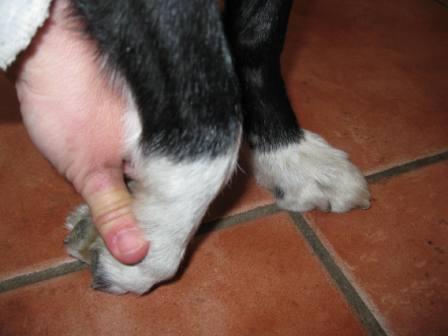Find out what veterinary neurologists look for when doing a veterinary neurology exam on pets.
In March 2012, I had the chance to attend (on a press pass) two days of the American Animal Hospital Association (AAHA) annual conference. It happened to be in Denver this year. My number one destination was a session called “Video Tour of the Neurologic Exam” by Dr. Simon Platt, who works / teaches at the University of Georgia’s College of Veterinary Medicine.
If you ever have the chance to hear Dr. Platt speak, take it. The man is very funny and has great videos to demonstrate what various neurological problems look like.
For obvious reasons my notes reflect mostly information that applies to Lilly’s case of meningoencephalomyelitis / meningoencephalitis (inflammation of the brain and lining of the brain and spinal cord) after an adverse vaccine reaction to a rabies vaccine.
I learned a few interesting things, however, that might be of use to you.
Questions Asked During a Veterinary Neurology Exam
When veterinarians assess a dog, Dr. Platt said the main questions to ask are … Who are you, and what are you doing? In other words, who is this animal normally, and how has that changed?
[In our case, Lilly went from being a healthy, strong dog with great balance and agility … to one who would barely walk or stand without falling over, who could not hold her head still, who could not even hold herself up to potty.]
Answers about an animal’s mental status, posture, and movement help you figure out:
- If what you’re seeing is neurological (vs orthopedic or something else)
- If what you’re seeing is “in the head” or “out of the head” (brain or spinal)
You’re mostly looking at movement – strength, coordination, or both:
- “Drunkenness” is neurological.
- Issues with strength are often out of the head (spinal).
- Toxins cause bilateral presentation, meaning both sides of the body are affected
Dr. Platt joked at one point that that 97% of cases are idiopathic (which essentially means of unknown cause / origin). Idiopathic cases usually show up as a single symptom.
That’s important. If there are other signs, like vomiting or fever, then there probably is a more distinct cause. [Lilly initially had several symptoms, including fever, lethargy, cognitive delay, ataxia (wobbly walking).]
Veterinary Neurology Exam Example
Dr. Platt showed a video example of a German Shepherd circling one direction. He told us that this dog was definitely neurological. He said the trouble was definitely in the head (meaning brain), and it was likely caused by tumor, inflammation, or stroke. Often depending on age of the animal, you can mostly rule out tumor or stroke.
Tumor or Inflammation? How to Tell in a Veterinary Neurology Exam
Dr. Platt explained that multifocal symptoms [like Lilly’s] are most likely inflammation (not stroke, not tumor). Multifocal simply means that there are clear indications that several areas of the brain or spine are involved. And, a veterinarian or veterinary neurologist can tell if something is multifocal by doing some easy physical manipulation of the dog — and often simply by watching the dog move naturally.
The neurological exam tells a lot, and often further tests (like MRI, etc) merely confirm what’s seen on exam. However, tests like that do show us the extent of the disease. [In Lilly’s case we knew it was bad, the MRI and spinal tap told us how bad and helped us rule out other potential causes of the inflammation.]
A full neurological exam can take as little as 5 minutes to decide:
- If it’s neurological or not
- If it’s in the head or out of the head.
Much of the neurological exam steps taught in vet school don’t really add much information to the differential diagnosis. This includes those reflex hammers. Dr. Platt joked several times of better uses for the hammers than banging them on dogs to test leg reflexes and such.
***
Neurologic Postural Reactions in a Veterinary Neurology Exam
Veterinarians use postural reactions to figure out if the animal knows where its feet are. [Lilly clearly did not, does not.]
 In a neurological exam, Dr. Platt advised, “Always start with knuckling because if that’s abnormal, then all other options – like wheel-barrowing or hopping – are a waste of time.”
In a neurological exam, Dr. Platt advised, “Always start with knuckling because if that’s abnormal, then all other options – like wheel-barrowing or hopping – are a waste of time.”
Knuckling just means having the dog stand still while you turn each of her feet under so that you can see how long it takes her to flip them back over. [When Lilly first got sick, she either would NOT turn her foot back to its normal position or was VERY SLOW to do so. That told veterinarians that her brain was in trouble.]
Spinal Reflexes
Again, Dr. Platt flat out said that using mallets to test reflexes of various kinds is a waste of time. He did, however, recommend checking for flexor withdrawal (pinching a foot and looking for reflexive drawback of the limb).
Even small amounts of reflex information can help narrow down where in the spine the trouble may be.
The one caveat is the pelvic limb flexor withdrawal in older dogs because it’s common for older dogs NOT to have this reflex.
Trouble in the Brain: How to Tell
Mostly looking for these indications:
- Midbrain: Pupil size, eye position
- Pons (upper brain stem): Facial sensation, masticatory muscles
- Medulla (lower brain stem): Face movement, vestibular issues, noise, tongue, respiration
It’s also good to know if the animal can see, which is where the Menace Response comes into play. Essentially, this test (threatening the animal’s eye to see if he blinks) lets you know if the animal can see or not. You can also tap lightly on the animal’s face to see if he blinks.
Platt joked, “This doesn’t work as well with cats because they aren’t as easily threatened (as dogs).”
Vestibular Issues
Vestibular symptoms can be neurological or ear based. Dr. Platt said to look for head tilt / ataxia (wobbly walking) / eye movement twitch (vertical eye twitching is always neurological).
***
If you are new to our scary story of a rabies vaccine gone horribly wrong, feel free to use the blog post category pull-down menu in the sidebar or this Adverse Vaccine Reaction category link to access all the posts we’ve published since Lilly got very, very sick with meningoencephalomyelitis / meningoencephalitis (inflammation of the brain and lining of the brain and spinal cord) after an adverse reaction to a rabies vaccine given January 23, 2012. We’re working VERY hard to help her fully recover from both her cognitive and neurological deficits.
***



VERY interesting information. Thanks so much for sharing it with us. I’ve been thinking back to one dog’s issue with a poisonous mushroom and another’s issue with eclampsia.
Thank you for the detailed report. God forbid I ever have a problem to this degree with a dog (though Elka does occasionally display the Doberman idiopathic head bob), and I’m so sorry that you’re going through it.